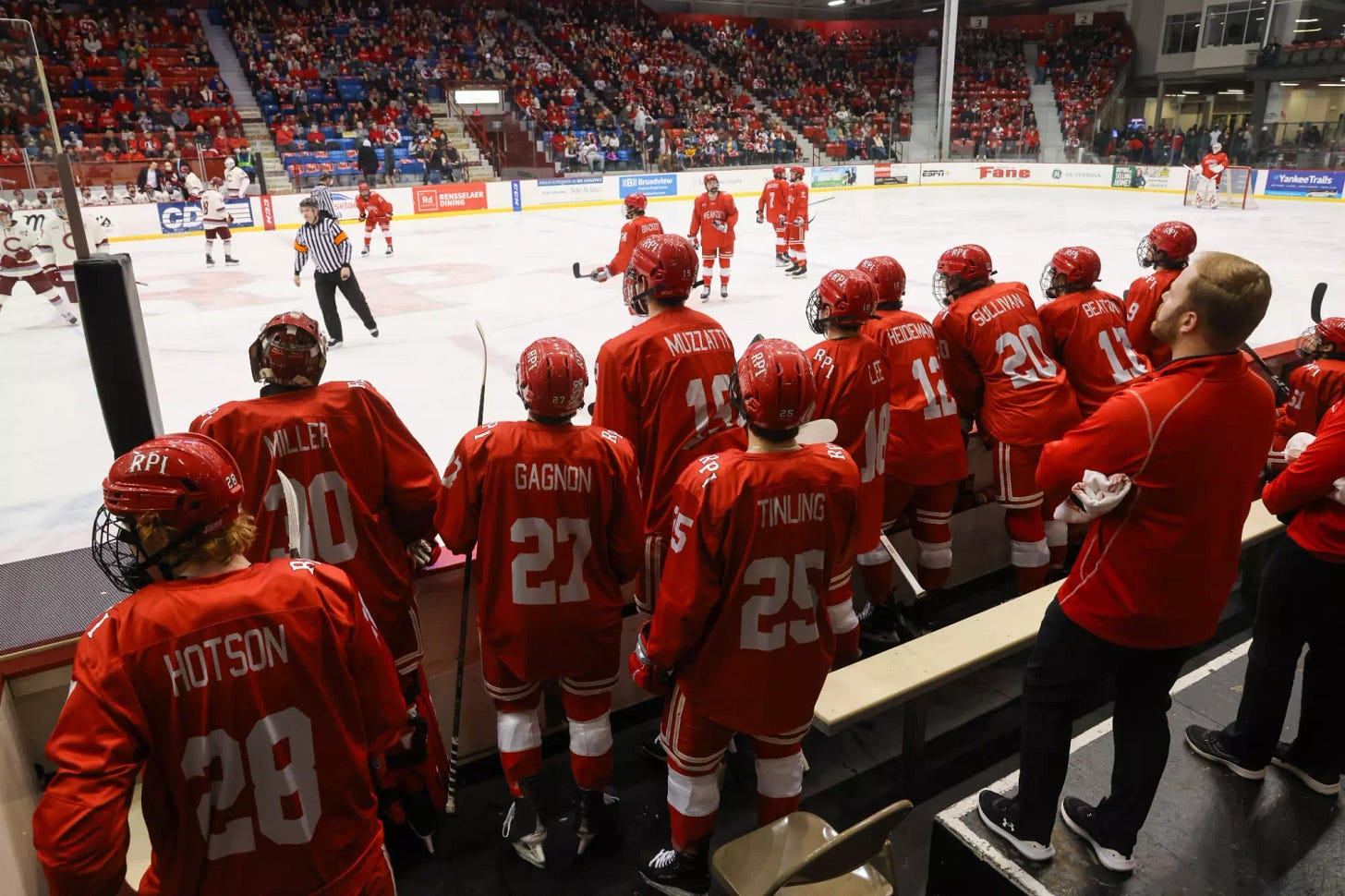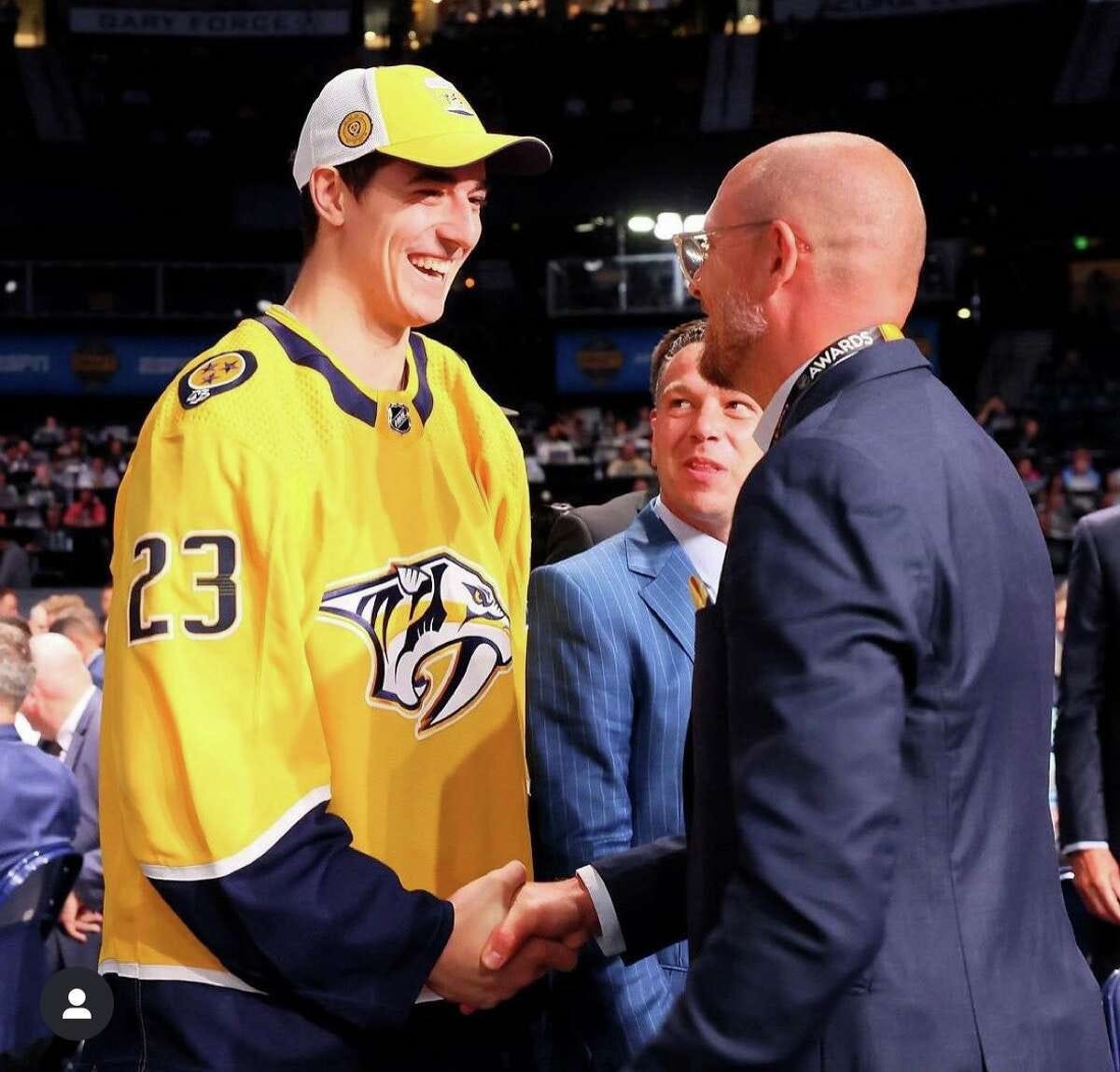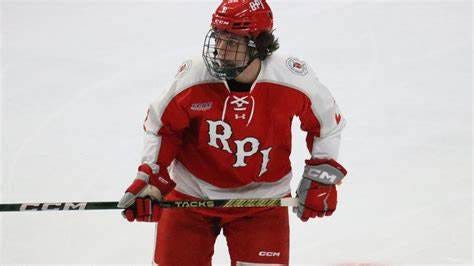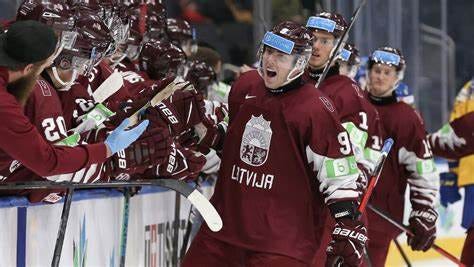The Three Tiers of the 24-25 Team
Who is the core? Who is the supporting cast? Who will be a pleasant surprise?
On Tuesday, the RPI Men’s Hockey social media pages officially welcomed the newcomers to the 2024-25 Engineer squad, thus finalizing the roster we have speculated over for months. The coaching staff has seemingly found a preferred balance in the ratio of returnees and newcomers in this new transfer portal era, and this year’s 11 newcomers fit this narrative. The program welcomes four transfers, one from Brown, Alaska Anchorage, UMass, and Ferris State respectively, as well as seven freshmen with BCHL, USHL, and NAHL experience. There was quite a bit of media surrounding the announcement on Tuesday, so we thought an article tying together where the roster lies would be useful. Closer to the start of the season we will take apart the individual position groups and where the strengths and weaknesses lie, but this article will accomplish something a bit different.
Not every roster is built the same, but I do feel that you can generally lump every player on a hockey team into one of three categories. Heading into a season, a player is either a definitive member of “the core”, he is a member of “the supporting cast”, or he falls in the “question mark” category. This year’s roster fits this description, so I thought it would be useful to look at how this roster tiers off, and level set some expectations for individual players. In my opinion, if 3/3 of these groups exceed expectations, RPI will be successful and headed for the top of the ECAC standings. If 2/3 are proficient, I would expect a home ice playoff berth and a middle of the pack finish. Anything less than that likely would not be characterized as a successful season. Let’s take a look at how the roster sets up and how I see the tiers being broken off.
Tier 1: The Core
Sutter Muzzatti, Tyler Hotson, Dovar Tinling, Jakob Lee, Max Smolinski, Jack Watson
Almost every great team has an essential core of players that fans associate with the team’s success. In practice, it takes a lot more than a few players to build a winner, but this group typically elevates the team to a level the other players are not capable of. In my opinion, these six players are the top-end of this year’s roster, all possessing all-league level abilities.
Sutter Muzzatti is most likely the team’s top player, but he battled injuries last year and will need to shake those to hit his potential. At the top of his game though, he can produce above a point-per-game and be an all-league player. Tyler Hotson is next for me, and I would not be surprised at all to see him lead the team in points. Hotson possesses an excellent IQ and drives play at an elite level. I expect a sizable jump for him coming off his successful freshman season. Tinling and Lee are on a similar level for me, but Dovar’s challenge will be about elevating his game, whereas Lee will look to return to 22-23 form. Both possess 25+ point potential in my opinion. I thought Max Smolinski was snake-bitten early last season, but really developed as the year went on and is on the verge of Will Reilly type production. He should quarterback a powerplay unit and continue to round his game out as the top Engineer defenseman. Finally, Jack Watson has been hot and cold throughout his career here, but I still believe in his ability quite a bit. Jack has battled injuries and bad defense but when his game is on, he is an elite goaltender. He spent the past week at Capitals camp, joining Smolinski (LAK) as the only Engineers to participate in an NHL development camp. A clean bill of health and improved defense should set him up for a monster senior year.
“The core” of a team often can carry a team to heights they otherwise would not reach, and I do believe this group is capable of it. Each of these players have flashed elite play, some of which have extended it for a long stretch. For this group to take the team where it wants to go, they will need to stay healthy and channel their top play throughout the season.
Tier 2: The Supporting Cast
Jake Gagnon, Jordan Tonelli, John Beaton, Felix Caron, Rainers Rullers, Brad McNeil, Elliott McDermott, Will Gilson, Nick Strom, Jimmy Goffredo, Jack Agnew, Noah Giesbrecht
The second defined unit I see on this roster is “the supporting cast”, which is by far the largest group there is. Many teams are defined by the depth of their roster, and in my opinion, for this team to succeed, it will need to mirror the 19-20 team and score throughout the lineup. For this to be the case, younger, emerging players will have to continue growing into bigger roles, and experienced players will need to put it all together and perform at the top of their game. This is likely the tier that will make or break the season in my opinion.
The first group in this tier that stands out is the younger players, notably Jimmy Goffredo, Brad McNeil, and Felix Caron. Goffredo and McNeil both showed promise in their freshman years and carved out roles in the middle of the lineup. The DNA of their games is a little different, but I think both players are poised for breakouts in their sophomore seasons. McNeil’s game reflects a lot of what Ture Linden did well, and the connection is easy to draw because they have a very similar development path coming out of the NAHL as overagers. If McNeil can add skill to his game the way Linden did, I could see him growing into a middle 6 center quickly. Felix Caron is the top recruit in this class and should make an immediate impact on offense and on the powerplay. I don’t feel that he is quite as ready as Tyler Hotson was, but his ability to carve out a role the way Hotson did will have a big impact on this team.
Perhaps the more important faction of this tier are the veterans, especially the ones that have been at RPI for a while now, such as John Beaton, Jack Agnew, Nick Strom, Jake Gagnon, and others. In my opinion, as with other college veterans, many of these players have flashed play that makes them difference makers, but they have also had their struggles. There is a rather large group of graduate students, partially because of the remaining eligibility for the recruiting class of Beaton, Lee, etc. The Engineers will need these players to deliver the way they have shown they can if the team wants to reach its potential. The depth added by the transfers combined with the younger players and the veterans makes the supporting cast very intriguing. Last year’s team appeared to have depth, but a lot of it fell apart and that led to the team’s struggles. If these players can add depth to the core of the roster, RPI will be very deep and difficult to play next year.
Tier 3: Question Marks
Jack Brackett, Jeremie Payant, Nathan Sullivan, Mathieu Bourgault, Jagger Tapper, Gustavs Ozolins, Lucas Matta, Brody Maguire, Carson Dorfman
Herein lies the part of the roster that is mostly an unknown commodity, made up of freshman or players whose roles are currently unclear. I have Rullers and Caron up a tier because they have extremely high pedigrees coming in and I expect them to play large roles right away. The rest of the freshman may start in more of a depth role before moving into the lineup full time. I do, however, think Gustavs Ozolins will start out in the lineup, he is touted for his IQ and puck-moving ability, so I could see him being 3rd LD on opening night. Jagger Tapper blossomed in Okotoks as the year went on, so he is another one I expect to eventually take up a role during the season. Brody Maguire is touted as a defensive minded defenseman, which the team certainly needed more of. I expect Mat Bourgault and Carson Dorfman to start in depth roles, but it is possible for them both to be lineup regulars at some point. Freshman are inherently question marks, but connecting on a few every year is always a huge shot in the arm for the depth of the roster. The Engineers could certainly use some of that in the 24-25 season.
The four returnees that I see as question marks are all different cases whom I expect to fill different roles. Jack Brackett is certainly closest to tier 2, but his offensive game is limited, and I could see some of the younger players eating into his time. If Jack plays to the top of his game though, he could be very helpful in the bottom 6 for Coach Smith. Nathan Sullivan and Jeremie Payant are very similar cases to me, both of whom had success in juniors but struggled in their freshman years. Neither produced an output that shows they can be counted on in big roles this year, but they both do have the skill to be difference makers. If even one of these guys begins to reach their potential, the top-9 outlook changes quite a bit. Finally, Lucas Matta struggled last year but was a heralded recruit and transfer, who I hope can rebuild his confidence. He is a strong skater and has the tools but will need to put them together to be a factor this year.
I would not expect all the question marks to be pleasant surprises and outperform expectations, but a few need to for the team to succeed. Surely any of them could make a sizable leap, but my money is on Ozolins, Tapper, and Sullivan to reach a new level and be consistent contributors this season. Adding a few key unexpected contributors could elevate the core and supporting cast to an even higher level.
The Big Picture
I believe that in hockey this exercise could be used for any team at the NCAA or professional level and is quite useful when it comes to level setting expectations for individual players. The unique part of this exercise is that very infrequently will these tiers end up looking anything close to the same by the end of the year. Therefore, I am going to come back to this at the end of the season and see what players individually deviated from the expectations I had for them.
For me, the math is fairly simple. Any team (including RPI) needs the core of their roster to perform at an elite level, it needs the supporting cast to add depth and insurance in case of injury, and it needs some of its unknown commodities to join the fray as frequent contributors. I feel that the tiers for RPI are very clear, and it will need these groups to meet and exceed their expectations. I think that if 2/3 of these groups exceed their expectations, the Engineers will have a very solid year. 3/3 would set the team up for a season we would all be overjoyed with. If I learned one thing from last season, it’s that a roster is not built on paper, and results can deviate from summer expectations. It will be on the coaching staff and the individual players to make the sum of the roster’s parts greater than the whole.





